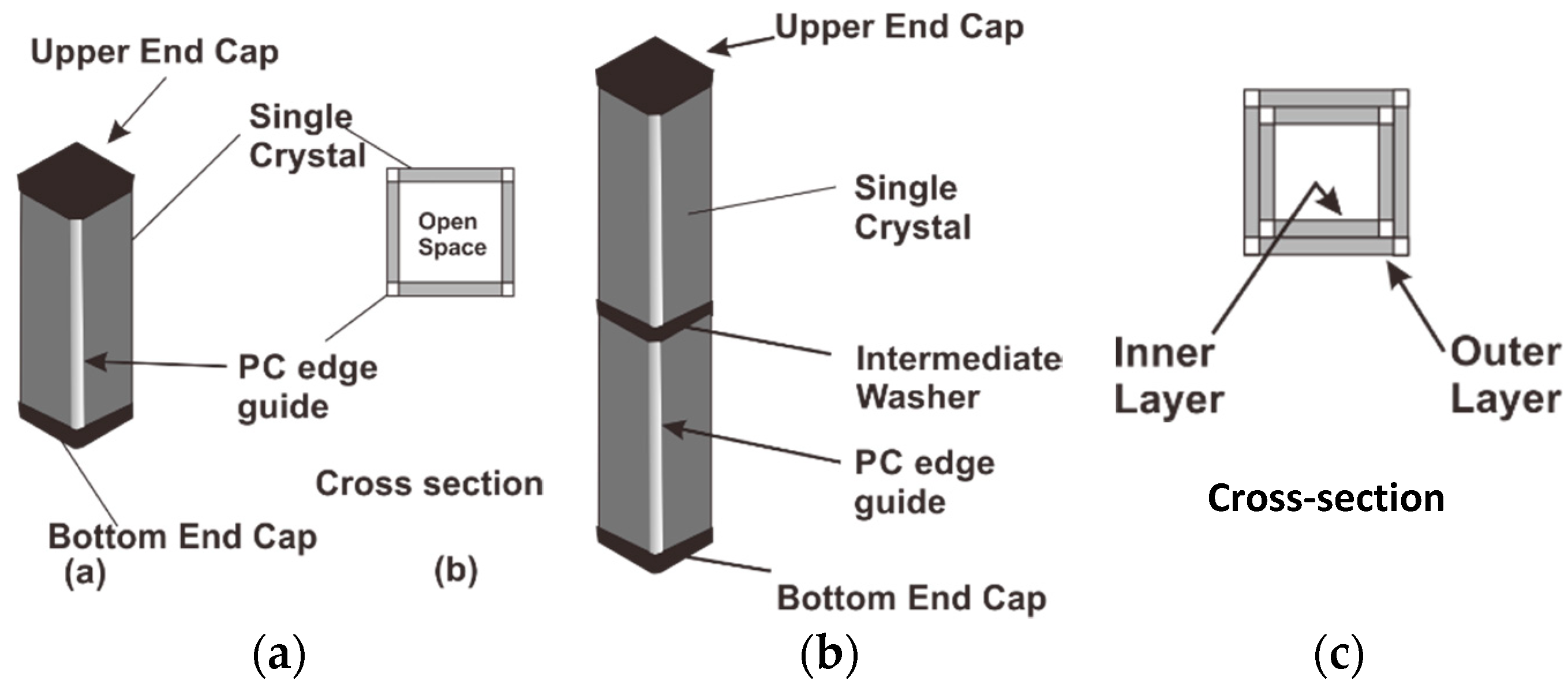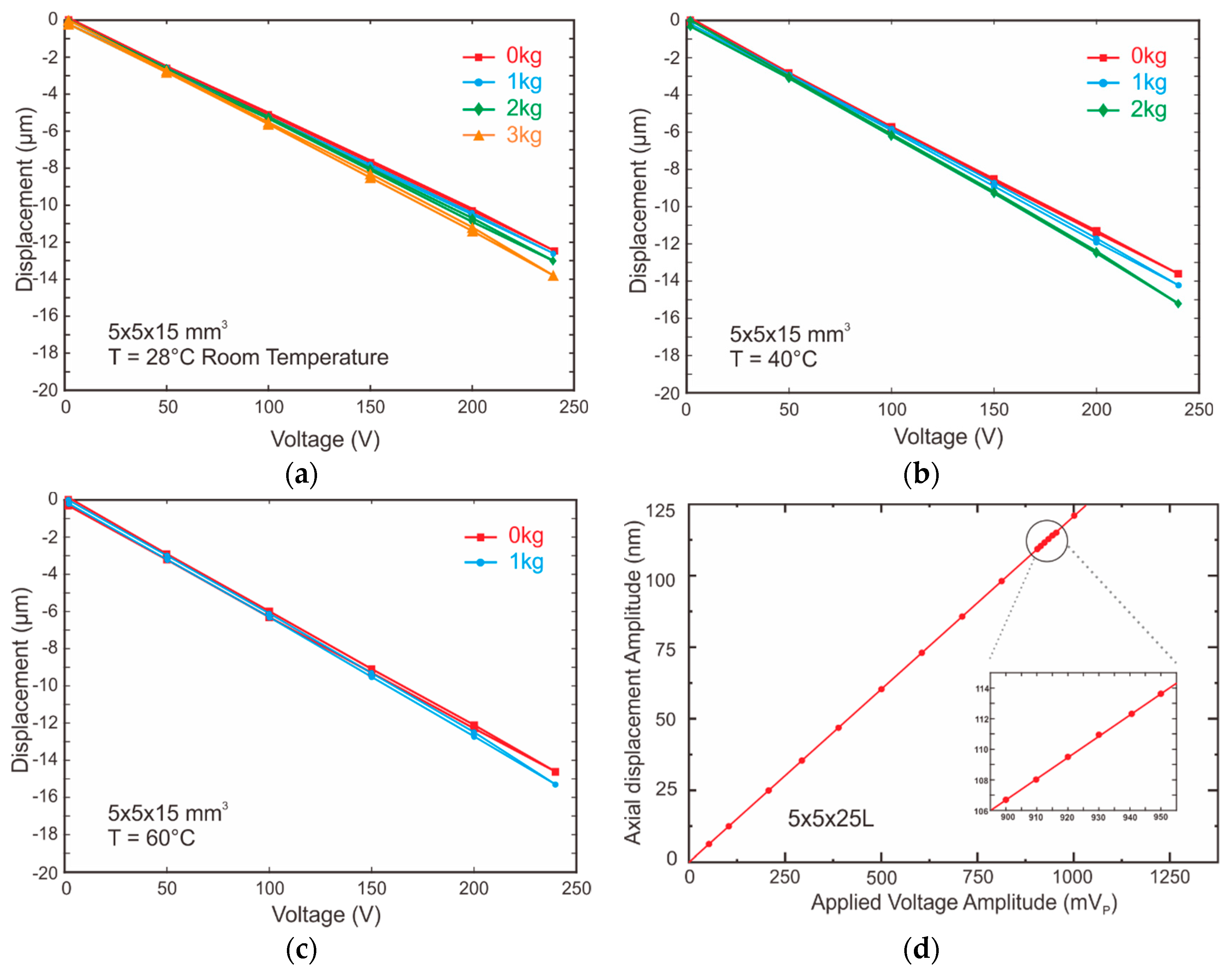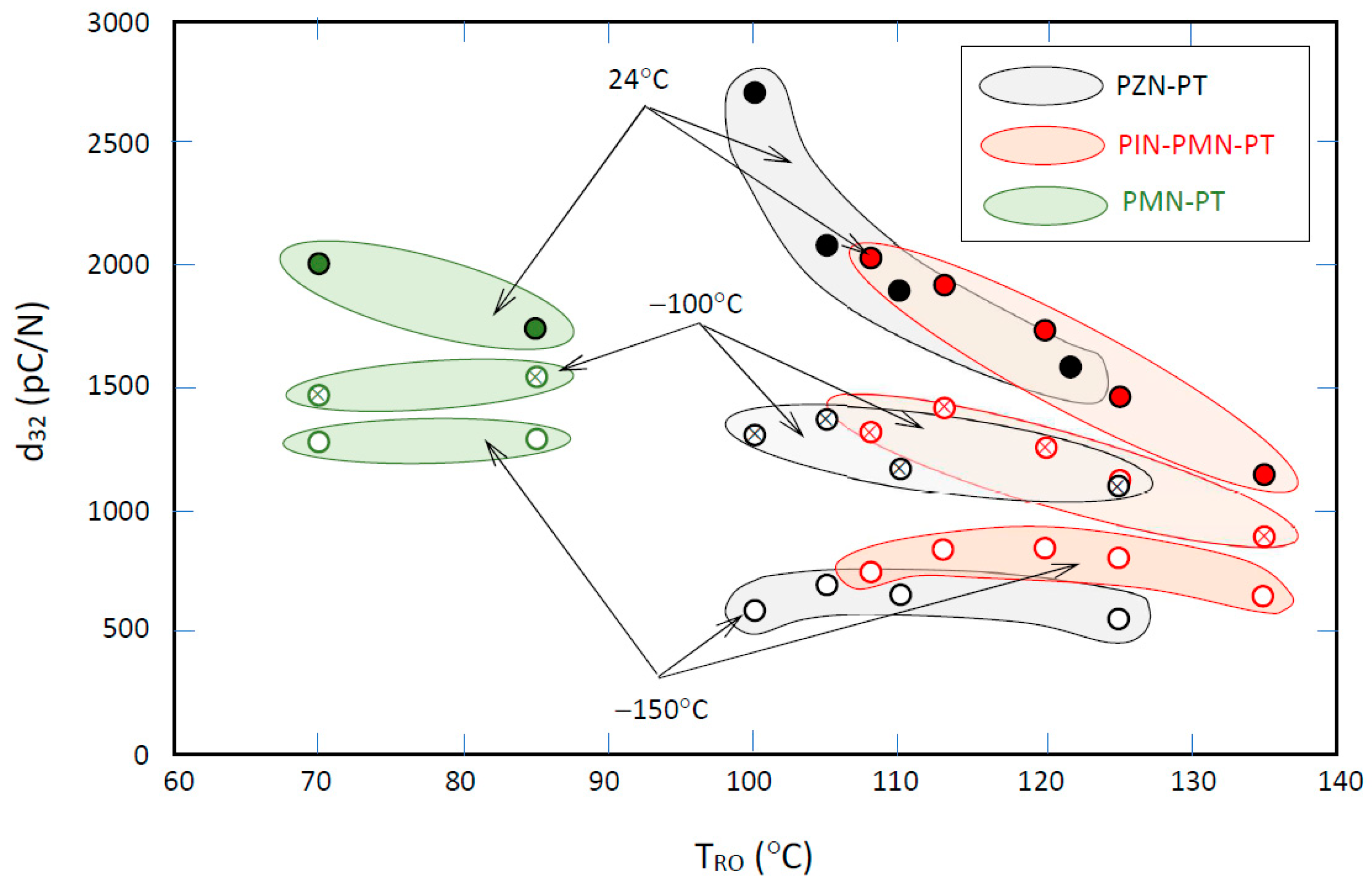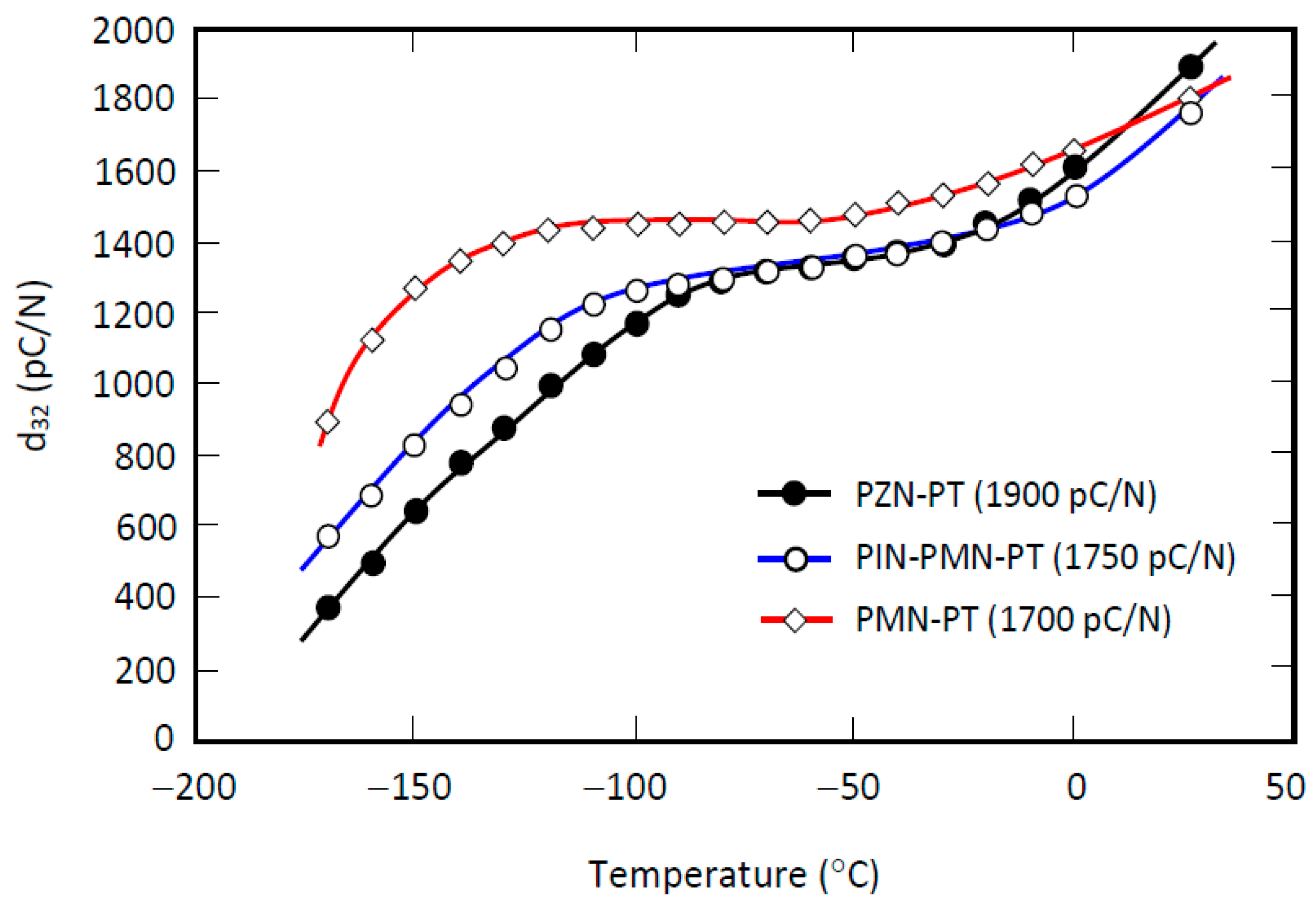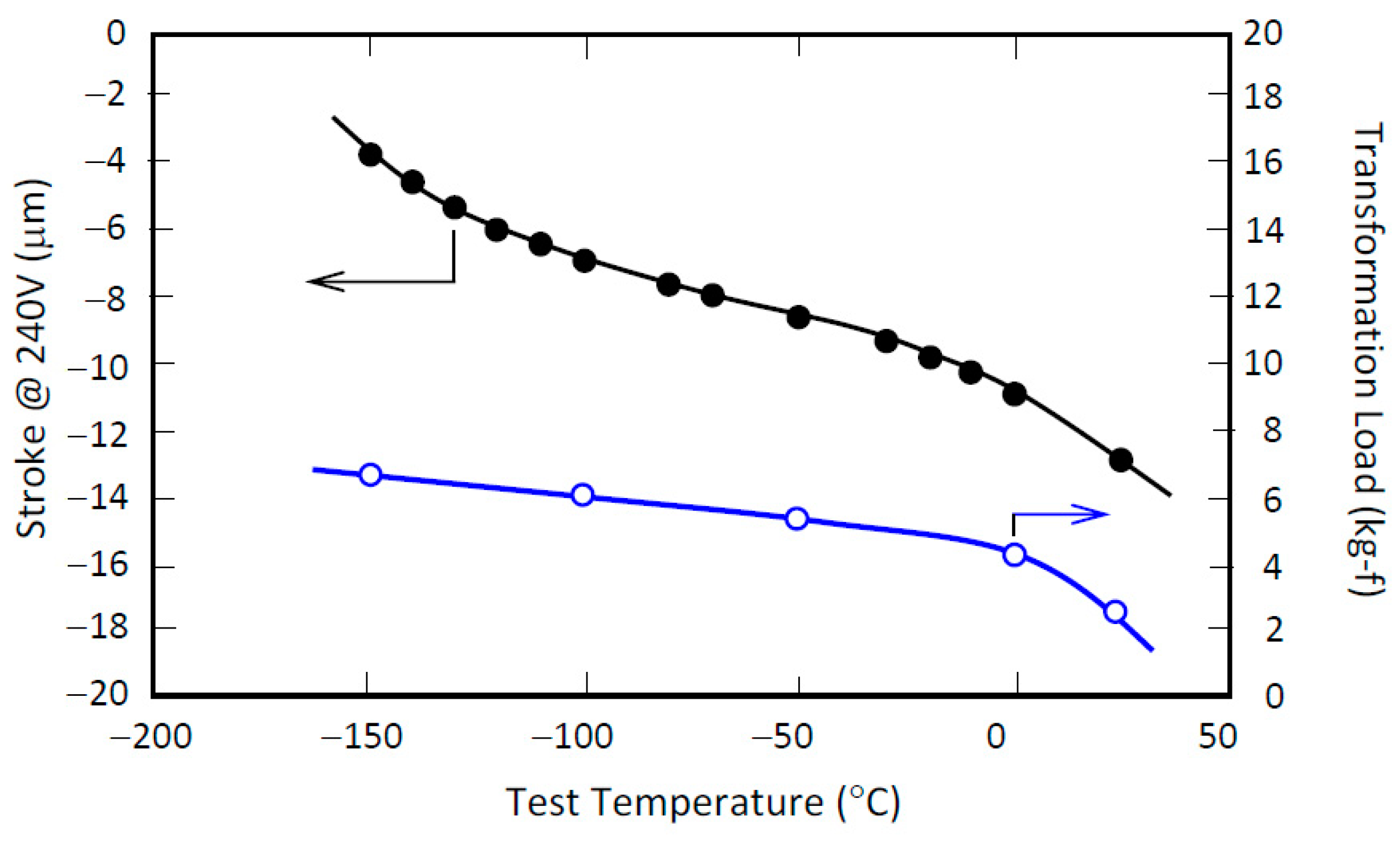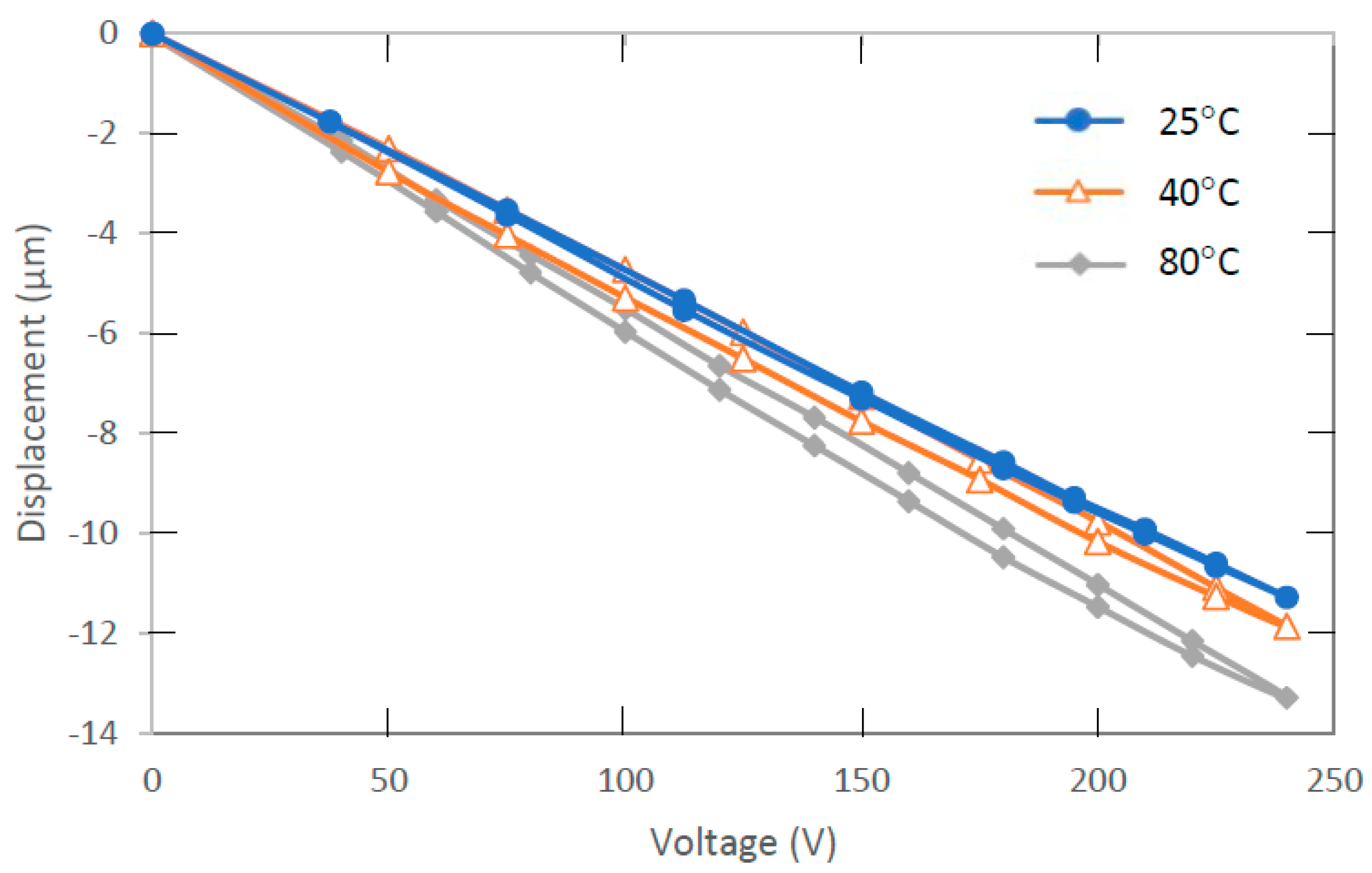1. Introduction
Lead-based relaxor-lead titanate (PT) solid solution single crystals, notably lead zinc niobate-lead titanate (Pb[Zn
1/3 Nb
2/3]O
3-PbTiO
3 or PZN-PT), lead magnesium niobate-lead titanate (Pb[Mg
1/3 Nb
2/3]O
3-PbTiO
3 or PMN-PT) and lead indium niobate-lead magnesium niobate-lead titanate (Pb[In
1/2 Nb
1/2]O
3-Pb[Mg
1/3 Nb
2/3]O
3-PbTiO
3 or PIN-PMN-PT), have attracted much attention in the last two decades [
1,
2,
3]. These single crystals display extraordinarily high piezoelectric coefficients, being 4× to 8× that of lead zirconate titanate (PZT) ceramics. They are thus potential candidate materials for high performance piezoelectric devices.
In addition to their high piezoelectric coefficients, these single crystals display linear strain response with minimum hysteresis especially those of rhombohedral structure having compositions sufficiently away from the morphotropic phase boundary (MPB) [
4,
5]. Their properties are highly orientation dependent, such that while [001]-poled relaxor-PT single crystals exhibit large longitudinal piezoelectric coefficient (d33), [011]-poled relaxor-PT single crystals show exceptional transverse piezoelectric activity when the active direction is also the [100] crystal direction, i.e., they display extremely large d32 value which is negative, meaning that a [011]-poled crystal will contract in the [100] crystal direction when a positive polarity voltage is applied to the crystal electrode faces.
There also have been attempts to make multilayer stack actuators out of these single crystals, notably PMN-PT [
6,
7]. The crystals were first thinned down sufficiently and multiple units of them, up to hundreds in number in certain cases, were then bonded with epoxy into a stack arrangement. However, despite remaining linear, the resultant stack actuators display observable strain hysteresis. One plausible reason for this could be the many layers of single crystal-electrode-epoxy materials within the stacked structure. Since respective layers of material may respond to the electric or mechanical excitation differently, this would lead to undesired local stresses within the structure and hence the strain hysteresis. Besides, fabrication of single crystal stack actuators is a very costly operation because not only the crystal itself is expensive but also the process involved is laborious and time-consuming.
In recent years, we have been experimenting with [011]-poled d
32-mode piezo single crystals and fabricate multi-stake actuators out of them. These multi-stake single crystal actuators display highly linear strain behavior with negligible hysteresis when operated within the rhombohedral phase state [
8,
9]. In what follows, we shall briefly summarize these findings and present the result of relevant new developments, including cryogenic (CG) and high-temperature (HT) HFS actuators.
2. “Hi-Fi Stake” Single Crystal Actuator
“Hi-Fi Stake” (HFS) piezoelectric single crystal actuators are fabricated by bonding four identical rectangular-shaped d
32-mode lead-based relaxor-PT single crystals with polycarbonate edge guides into a square-pipe construction and further capped with top and bottom end caps at both ends (see
Figure 1a) [
8,
9]. They offer the following key advantages: (a) improved bending stiffness and strength with minimum crystal volume; (b) unlike transverse-mode single crystal tube structure, all crystals exhibit same axial strain response and (c) minimum number of epoxy joints hence structural-heterogeneity. Both (b) and (c) minimize structural heterogeneities and undesired local stresses and strains within the device during crystal excitation which, together with the linear response of individual single crystals, entail the linear strain response with negligible hysteresis of the resultant device.
Current Hi-Fi stake actuators are made of PZN-PT and/or PIN-PMN-PT d32-mode piezo single crystals. These crystals have reasonably high transformation temperature of 105–125 °C and piezoelectric coefficients. This enables the resultant actuators to display reasonably large stroke at low voltages, at up to 60 °C with payload. Furthermore, the strain and displacement responses are highly linear with negligible hysteresis.
At present, three main types of Hi-Fi Stake (HFS) are available (see
Figure 1): (a) cost-effective (CE), (b) large-stroke (LS) and (c) high-load (HL). Cost-effective Hi-Fi Stake (CE-HFS) actuator has the basic square-pipe construction (
Figure 1a). Large-Stroke Hi-Fi Stake (LS-HFS) has a 2-level square-pipe structure (
Figure 1b) for increased device active length, while High-Load Hi-Fi Stake (HL-HFS) has an inner and outer 2-layer square-pipe construction (
Figure 1c) for increased crystal load bearing area.
Table 1 shows the performance of selected HFS actuators of respective constructions.
Figure 2a–c show the displacement responses of selected HFS actuators. The crystal thickness was kept at around 0.4 mm and the maximum applied voltage was fixed at 240 V. Detailed descriptions of the experimental techniques used for the measurement of displacement, stroke and maximum load allowed can be found in [
8,
9].
These figures show that Hi-Fi Stake single crystal actuators are highly linear with negligible hysteresis when used within the specified conditions. Shown in
Figure 2d is a displacement curve obtained by laser vibrometry technique using a HFS actuator sample of 5 × 5 × 28 L mm in dimensions. It shows that the actuator displays 1.5 nm displacement amplitude at 10 mV
p, corresponding to 0.15 nm resolution at 1 mV
p.
In what follows, we shall describe two new developments of Hi-Fi Stake single crystal actuators: Cryogenic Hi-Fi Stake (CG-HFS) and High-Temperature Hi-Fi Stake (HT-HFS).
3. Cryogenic Hi-Fi Stake (CG-HFS) Actuator
Piezoelectric actuators and motors have been deployed in many space applications due to their fast and precision response, and being free of electromagnetic interference. For such application, the actuators must be compact and light, with adequate stroke and payload, and consume minimum power [
11,
12]. While piezoelectric actuators made of piezoceramics are widely used, they lose up to 75% of their piezoelectric performance at cryogenic temperatures, severely limiting the strain available [
12]. In contrast, recently available lead-based relaxor-PT single crystals not only have several times higher piezoelectric coefficients than present-day piezoceramics but also retain a larger portion of piezoelectric strain at cryogenic temperatures [
13,
14]. They thus make possible actuators with significantly higher piezoelectric performance both at room and cryogenic temperatures.
In this work, the cryogenic d
32 values of different relaxor-PT single crystals were studied by the resonance technique using a home-made cryogenic test cell which also allows for concurrent application of electric voltage and axial compressive load to the single crystal and/or actuator samples. Using liquid nitrogen as the cooling medium, the minimum test temperature that the set-up can attain is around −170 °C. This temperature is lower than what a space craft will experience when it is completely blocked out of the sunlight by the earth [
15].
The following three crystal systems were investigated: PZN-PT and derivatives (including doped and ternary), PIN-PMN-PT and PMN-PT crystals. The results are summarized in
Figure 3.
Figure 3 shows that at room temperature, PZN-PT (and its derivatives) and PIN-PMN-PT single crystals exhibit comparable d
32 and T
RO values of 1400–2200 pC/N and 110–125 °C. More specifically, within said d
32 range, the T
RO of PIN-PMN-PT crystals are about 3–5 °C higher than that of PZN-PT for a given d
32 value. Additionally, while PZN-PT crystals of higher PT contents (i.e., those of ≥6%PT) display extremely high d
32 values of ≥2400 pC/N, PIN-PMN-PT crystals of compositions away from the MPB show higher T
RO of 125–135 °C despite having smaller d
32 values of 1100–1500 pC/N. PMN-PT single crystals also exhibit comparable d
32 values at room temperature. They, however, have significantly lower T
RO compared with PZN-PT and PIN-PMN-PT.
Typical d
32 versus temperature curves of representative crystal compositions are provided in
Figure 4. This figure shows that over the temperature range from room temperature to −50 °C, the d
32 values decrease steadily for all the three crystal systems. At −50 °C, PZN-PT and PIN-PMN-PT crystals retain about 75–80% of their room temperature d
32 value, while PMN-PT crystals retain about 80–85%.
The rates of decrease in d32 value subsize significantly for all the three crystal systems over the temperature range from −50 °C to −110 °C. While the rates of decrease are comparable for both PZN-PT and PIN-PMN-PT crystals, with the former showing slightly higher rate, it is a lot more gradual for PMN-PT crystals. As a result, PZN-PT crystals retain about 60%, PIN-PMN-PT about 70% and PMN-PT crystals about 80% of their room temperature d32 values at −100 °C.
Over the temperature range from −110 °C to −170 °C, the rates of decrease in d32 increase again for all the three crystal systems. The rates of decrease are again comparable for PZN-PT and PIN-PMN-PT. In contrast, PMN-PT crystals display a higher decreasing rate over this temperature range. As a result, at −150 °C, the d32 values of PZN-PT, PIN-PMN-PT and PMN-PT crystals are about 30–40%, 40–50% and 50–60% of their respective room temperature values.
Figure 3 shows that the d
32-values at −100 °C of the three crystal systems are: 1200–1400 pC/N for both PZN-PT and PIN-PMN-PT and 1400–1600 pC/N for PMN-PT. At −150 °C, the d
32 values are: 550–750 pC/N for PZN-PT and derivatives, 750–900 pC/N for PIN-PMN-PT and 1150–1300 pC/N for PMN-PT single crystals. All the above values are significantly higher than d
33 ≈ 350–600 pC/N for PZT piezoceramics at room temperature which drops to 25–30% of said value at cryogenic conditions.
The present results suggest that similar crystal composition and device construction to that of cost-effective stake (CE-HFS) actuators are also suitable for cryogenic applications when low out-gasing cryogenic epoxy is used in their fabrication. The cryogenic performance of a PIN-PMN-PT CG-HFS prototype, 5 × 5 × 15 L mm
3 in dimensions, is provided in
Figure 5. This sample registers a stroke of −12.8 μm under 240 V at room temperature, which decreases to −10.9 μm at 0 °C, −8.4 μm at −50 °C, −6.9 μm at −100 °C, and further to −3.9 μm at −150 °C. While the measured strokes reflect closely the variation of d
32 with temperature shown in
Figure 4, its value at −150 °C is only 30–35% that at room temperature. This is possible considering the much increased elastic modulus of the polymer edge guides and the associated mechanical constraint they impose onto the crystals at cryogenic temperatures.
The transformation loads of the above-said actuator sample at different test temperatures under 240 V were determined by adding weights to the actuator sample until a change in slope in the displacement curve was noted, corresponding to a change in crystal elastic stiffness and hence phase present. The obtained values are provided in
Figure 5. Above said loads, local rhombohedral-to-orthorhombic phase transformation may occur in the crystals leading to deviation from linearity of the displacement response and observable strain hysteresis. The result shows that the transformation load increases substantially at cryogenic temperatures. For instance, at −50 °C, it is 1.5× the value at room temperature and about 2× as the temperature is lowered to −100 °C and below.
Based on the measurement data, the performance of 5 × 5 × 15 L CG-HFS can be deduced. The results are provided in
Table 2, in which the maximum loads allowed are taken as 0.9× that of the transformation loads. Larger strokes are expected when longer lengths of single crystal active material are used. Alternatively, since both the transformation voltage and axial compressive load increase substantially at cryogenic temperatures, under low payload condition, one may decrease the crystal thickness and/or increase the applied voltage to attain higher axial displacement when such is advantageous. However, this should be done with care, such that there is no occurrence of local phase transformation in the single crystal active material.
Similar to CE-HFS, CG-HFS stake actuators made of PZN-PT/PIN-PMN-PT crystals can be used up to 60 °C with payload. At and below said use temperature and under above-described cryogenic conditions, MMT CG-HFS stake actuator displays linear strain responses with minimum hysteresis.
The above-described CG-HFS prototype, of 5 × 5 × 15 L mm in dimensions, has a capacitance of about 18 nF. This is much smaller than that exhibited by stack actuators of comparable dimensions made of either d
33-mode PMN-PT single crystal or PZT piezoceramics, being low to high hundreds of nF or even larger [
11,
15]. Since the a.c. power consumption is proportional to the product of device capacitance and square of a.c. applied voltage, taking typical applied peak voltage at 150 V for stack actuators, a.c. power consumption of PZN-PT/PIN-PMN-PT single crystal stake actuators is thus only about 1/4 to 1/20 that of PZT (and PMN-PT single crystal) stack actuators despite a higher drive voltage of 240 V. MMT CG-HFS single crystal stake actuators thus not only offer reasonable stroke and payload at cryogenic temperatures but also linear, non-hysteretic strain behavior and reduced power consumption characteristics. The economic use of single crystal volume also offers attractive cost advantage compared to PMN-PT single crystal stacks.
Figure 3 further shows that d
32-mode PMN-PT single crystals also make excellent cryogenic stake actuators, giving 1.5× larger stroke than that made of PZN-PT/PIN-PMN-PT crystals. Despite so, it should be noted that PMN-PT single crystals have low T
RO of 65–90 °C. This results in their low maximum use temperature of 30–40 °C for stake actuators made from them. At above-said use temperature, PMN-PT single crystal stake actuators may display nonlinear and hysteretic strains due to local phase transformation occurring in the crystal, especially at sufficiently high applied voltage (of >150 V) and under payload condition. Hence, the environment should be controlled to not more than 40 °C; otherwise PIN-PMN-PT or PZN-PT crystals should be used to make cryogenic stake actuators.
4. High-Temperature Hi-Fi Stake (HT-HFS) Actuator
In the development of CE-, LS- and HL-HFS actuators, care had been exercised in the selection of crystal composition and dimensions, such that the resultant stakes can achieve a reasonably high use temperature of around 60 °C under payload (see
Table 1 and
Figure 2). Despite so, when tested at 70 °C or higher, these actuators start to display non-linear, hysteretic strains even with no payload. This holds for PMN-PT, PZN-PT and PIN-PMN-PT crystal systems of commercially available compositions. In other words, to extend the maximum use temperature to 80 °C, new crystal systems of superior transformation properties, notably transformation temperature, are needed.
Shown in
Table 3 are the T
RO, electrical and piezoelectric properties of two PIN-PZN-PT crystal compositions: one of MPB and the other of rhombohedral state. The higher T
RO of this crystal system is striking, being ≥150 °C for PIN-PZN-PT(MPB) and ≥165 °C for PIN-PZN-PT(R). Both compositions also have relatively high d
32 values, suggesting that they are candidate materials for high-temperature Hi-Fi-Stake (HT-HFS) actuators.
Figure 6 shows the displacement responses at various test temperatures of an experimental 5 × 5 × 15 L actuator sample made of d
32-mode crystals of PIN-PZN-PT (MPB). The displacement curves remain linear even at 80 °C but hysteresis strains become apparent at the two higher temperatures, being about 3.8% and 4.7% at 40 °C and 80 °C, respectively. The transformation loads at different test temperatures under 240 V were determined similarly as described above, from which the maximum loads allowed at respective temperatures were deduced (taken as 0.9× the transformation loads). The results are provided in
Table 4. It is evident that PIN-PZN-PT(MPB) crystals are suitable for making HT-stake actuators. The observed hysteresis may be attributed to the higher dielectric loss of 0.005–0.008 for this crystal composition (
Table 3).
Our next plan is to fabricate stake actuators out of PIN-PZN-PT(R) crystals. This crystal has a smaller d-value but also lower dielectric loss (
Table 3). It is thus of interest to evaluate the performance characteristics of stake actuators made of it and compare them with that made of PIN-PZN-PT(MPB) described in this work. We shall report our finding in due course.
